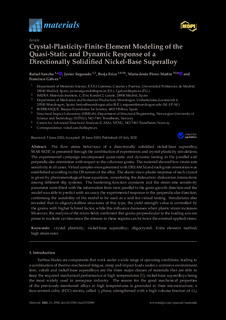Izenburua
Crystal-plasticity-finite-element modeling of the dynamic response of a directionally solidified nickel-based superalloyEgilea
Argitalpen data
2020Beste erakundeak
Universidad Politécnica de Madrid (UPM)IMDEA Materials
Ikerbasque
Norwegian University of Science and Technology (NTNU)
Bertsioa
Bertsio argitaratuaDokumentu-mota
ArtikuluaArtikuluaHizkuntza
IngelesaEskubideak
© 2020 by the authors. Licensee MDPI, Basel, SwitzerlandSarbidea
Sarbide irekiaArgitaratzailearen bertsioa
https://doi.org/10.3390/ma13132990Non argitaratua
Materials Vol. 13. N. 13, 2020Gako-hitzak
crystal plasticity
nickel-base superalloy
oligocrystal
Finite element method ... [+]
nickel-base superalloy
oligocrystal
Finite element method ... [+]
crystal plasticity
nickel-base superalloy
oligocrystal
Finite element method
high strain rates [-]
nickel-base superalloy
oligocrystal
Finite element method
high strain rates [-]
Laburpena
The flow stress behaviour of a directionally solidified nickel-base superalloy,MAR-M247, is presented through the combination of experiments and crystal-plasticity simulations.The e ... [+]
The flow stress behaviour of a directionally solidified nickel-base superalloy,MAR-M247, is presented through the combination of experiments and crystal-plasticity simulations.The experimental campaign encompassed quasi-static and dynamic testing in the parallel andperpendicular orientation with respect to the columnar grains. The material showed low strain-ratesensitivity in all cases. Virtual samples were generated with DREAM3d and each grain orientation wasestablished according to the DS nature of the alloy. The elasto-visco-plastic response of each crystalis given by phenomenological-base equations, considering the dislocation–dislocation interactionsamong different slip systems. The hardening-function constants and the strain-rate sensitivityparameter were fitted with the information from tests parallel to the grain-growth direction and themodel was able to predict with accuracy the experimental response in the perpendicular direction,confirming the suitability of the model to be used as a tool for virtual testing. Simulations alsorevealed that in oligocrystalline structures of this type, the yield-strength value is controlled bythe grains with higher Schmid factor, while this influence decreases when plastic strain increases.Moreover, the analysis of the micro-fields confirmed that grains perpendicular to the loading axis areprone to nucleate cavities since the stresses in these regions can be twice the external applied stress. [-]
Sponsorship
Research Council of NorwayProjectu ID
Centre for Advanced Structural Analysis (SFI-CASA) (project number 237885)Bildumak
Item honek honako baimen-fitxategi hauek dauzka asoziatuta:






















